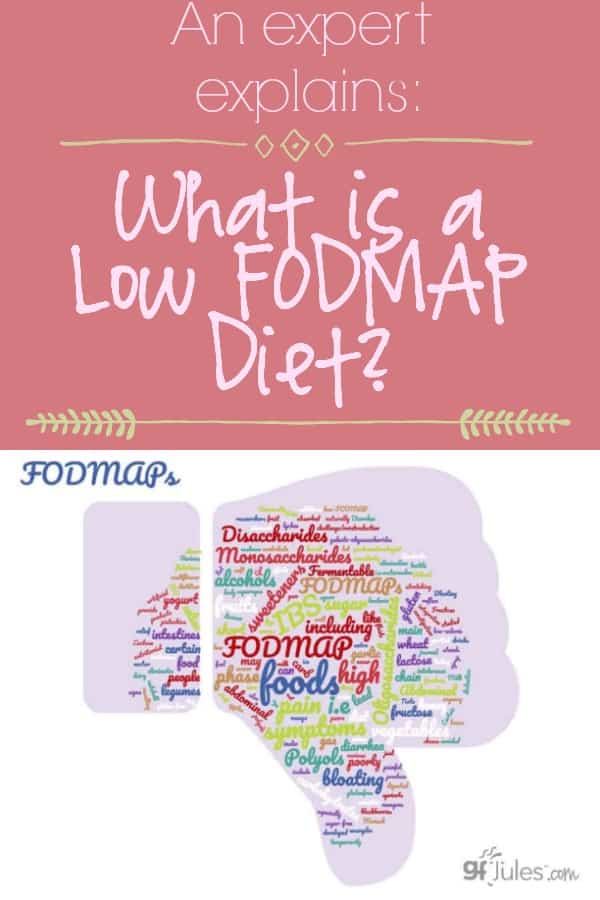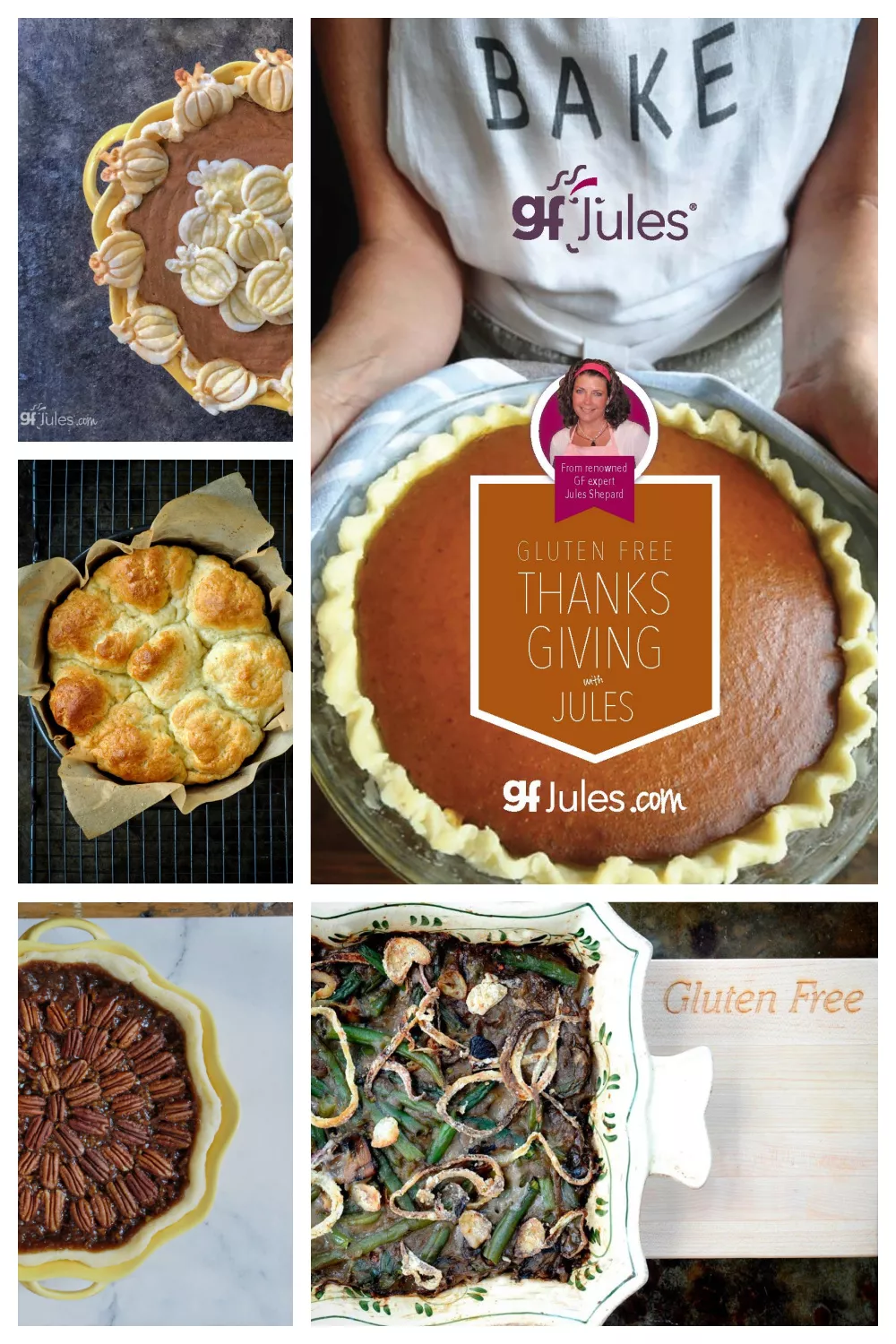I get a lot of questions about the FODMAP diet: everything from who needs to follow it to what is a Low FODMAP diet anyway?
Let me first answer the most frequently asked question: yes! My gfJules Gluten Free All Purpose Flour IS considered Low FODMAP. It contains tapioca, corn, potato and rice: all non-GMO and low in FODMAPs. Having this base ingredient on hand makes it much easier to bake up yummy options (click here for a list of low FODMAP fats to choose from in your gluten-free baking).
But beyond that, how and why would you follow a Low FODMAP diet and how on earth do you DO it?
For more options and insight into the Low FODMAP diet, I decided to turn to an expert for her perspective on counseling clients who are interested in trying a Low FODMAP diet, learning how to undertake the diet and understanding how long they should follow the diet. The idea being that most people don’t need a forever diet as restrictive as Low FODMAP, but by eliminating lots of gas-causing foods and then re-introducing them after a time, folks can identify what might be trigger foods for their own symptoms, and reduce or eliminate only those foods going forward.
Personally, I’ve found I can’t tolerate fructans very well (onions, garlic and wheat – of course!), so I avoid those but continue to enjoy other foods, some of which do contain FODMAPs.
So I asked my friend E.A. Stewart to share her advice. E.A. is a well-respected nutrition coach, integrative dietitian, gluten free recipe developer, and digestive health expert. One of the reasons I love E.A. is that her philosophy is not one of deprivation.
 In her own words, “My nutrition philosophy is simple…no one diet fits all, but a healthy diet is built upon whole, fresh, minimally processed ingredients, with room to enjoy your favorite foods. Life’s to short not to eat the damn cookie!” (See what I mean? How cool is that?) Here’s a link to her education and professional background, for those who’d like to know more.
In her own words, “My nutrition philosophy is simple…no one diet fits all, but a healthy diet is built upon whole, fresh, minimally processed ingredients, with room to enjoy your favorite foods. Life’s to short not to eat the damn cookie!” (See what I mean? How cool is that?) Here’s a link to her education and professional background, for those who’d like to know more.
Please feel free to leave questions or comments on this post and I, and or E.A., will respond. I’d love to know if you’ve tried a Low FODMAP diet and it’s helped you in any way. Would you like more Low FODMAP recipes? What ingredients do you rely on most when reducing FODMAPs in your diet? Do tell!
For now, I’m turning it over to E.A.:
Thanks so much Jules for inviting me to talk to your readers about the low FODMAP diet! I’ve helped many clients, who have been struggling with IBS (Irritable Bowel Syndrome) for years, finally find relief from their symptoms on a low FODMAP diet. I’m excited to help you and your readers learn more about the low FODMAP diet, what foods to eat and which ones to avoid, and share some quick, easy, and DELICIOUS low FODMAP recipes as well!
What is a Low FODMAP Diet & Who Should Try It?
The low FODMAP diet, developed and studied by researchers at Monash University in Australia, has been shown to provide relief from IBS symptoms in up to 75% of people who try it.
It temporarily eliminates certain foods that are high in FODMAPs {Fermentable Oligosaccharides, Disaccharides, Monosaccharides, And Polyols}, that can contribute to painful IBS symptoms.
These include fructans {i.e.watermelon, garlic, onion, wheat, inulin}, galacto-oligosaccharides {i.e. legumes, pistachios, cashews}, lactose {i.e. milk, ice cream, yogurt}, excess fructose {i.e. apples, mango, asparagus, honey}, and polyols {i.e. apricots, nectarines, pears, cauliflower, & sugar alcohols}. Note: This is just a partial listing of high FODMAP foods.
In a nutshell, FODMAPs are short chain carbohydrates and sugar alcohols that are poorly digested, and may lead to IBS symptoms including gas, bloating, abdominal pain, constipation, and diarrhea.
Not only are these high FODMAP foods fuel for bacteria which produce gas and stretching of these intestines, especially in people who are extra sensitive to the effects, they also pull fluids into the intestines which can lead to diarrhea.
If you have been diagnosed with IBS, {and other diagnoses have been ruled out}, a trial of a low FODMAP diet is definitely worth a try!
What Can I Eat On a Low FODMAP Diet
Although a Low FODMAP diet may seem extremely restrictive at first, there are MANY foods you can still eat.
Just a small sample of what you can eat during the elimination phase of the Low FODMAP diet…
- Fruit: Most berries, citrus fruit & melon, grapes, kiwi, & more.
- Veggies: Bell peppers, cabbage, carrots, cucumber, leafy greens, lettuce, potatoes, tomatoes, & more.
- Grains: Corn, oats, quinoa, rice, & more.
- Nuts/Seeds: Almonds, chia seeds, pecans, pumpkin seeds, walnuts, & more.
- Legumes: Garbanzo beans, lentils, & peanuts.
- Dairy: Hard cheeses, lactose free dairy, & more.
- Herbs & Spices: Almost all.
- Eggs/Fish/Meat/Oils: All plain versions as FODMAPs are only in carbohydrate containing foods.
If you’ve visited other websites, and have noticed a discrepancy between high/low FODMAP food lists, this is likely because foods are continuously being tested and updated for FODMAP content. For the most complete & up-to-date list, I highly recommend The Monash University Low FODMAP Diet App.
How to Follow a Low FODMAP Diet
The Low FODMAP diet consists of an elimination phase, a challenge/reintroduction phase, and an integration phase.
Step 1 Eliminate…
During the elimination phase, which typically lasts 2-6 weeks, or about 4 weeks on average, high FODMAP foods should be avoided as much as possible. I emphasize to my clients, however, that unlike someone with celiac who has to follow a strict gluten free diet, there is no evidence that eating higher FODMAP foods causes any damage to the digestive tract. Hopefully this takes some of the anxiety away of having to follow the diet perfectly, as we know that anxiety can exacerbate IBS symptoms.
Step 2 Challenge…
After the elimination phase, assuming GI symptoms have improved, the next step is to start reintroducing high FODMAP foods back in to the diet, one-by-one, to see which ones you can personally tolerate. It’s important not to rush this phase, as the overall goal is to be able to add as many higher FODMAP foods back into the diet without triggering GI symptoms.
I highly recommend keeping a food/symptom journal during this phase, and working with a dietitian nutritionist with expertise in the low FODMAP diet, if needed.
Step 3 Integrate…
After you have discovered your personal FODMAP food triggers, the next step is to integrate all the foods you CAN eat into your diet, focusing on eating a wide variety of nourishing and delicious foods, while minimizing GI symptoms. This may mean you even eat some of your high FODMAP trigger foods from time-to-time.
For instance, I work with a lot of clients who travel regularly, and eating a strict low FODMAP diet during trips isn’t always realistic. In this case, we come up with a plan that works for them~perhaps they’ll eat low FODMAP foods for breakfast and lunch, allowing them to eat some higher FODMAP foods for dinner, while still minimizing symptoms.
The integration phase is also a good time to explore other IBS management strategies, including gut directed hypnotherapy, stress management techniques, exercise, and supplements, including probiotics, fiber, and digestive enzymes. Although the research is limited, digestive enzymes that help with lactose digestion {in milk} and galacto-oligosaccharides digestion {in beans & somenuts} may allow you to add these foods back into your diet.
Indeed, as researchers are learning more about the potential benefits of a healthy gut microbiome, it’s a good idea to try and add a variety of prebiotic and probiotic rich foods into the diet, as long as you’re able to tolerate them with minimal GI symptoms.
If you find yourself still having a lot of symptoms after a trial of the Low FODMAP, or you find yourself on a limited diet, please consult with your physician or a dietitian specializing in digestive disorders to help guide you towards the next steps to getting healthy.
How to Eat Deliciously on a Low FODMAP Diet
Fortunately, with the popularity of the low FODMAP diet, there’s no shortage of nourishing and delicious low FODMAP recipes. Here are just a few low FODMAP recipes to choose from (click on each one to go to recipe):
- Fresh and Easy Quinoa Tabbouleh
- Gluten-Free Overnight Oats or Waffles
- Gluten Free Granola Pancakes
- Gluten Free Fruit Crisp
- Easy Low Carb Rosemary Pecan Chicken Salad on Zucchini Chips
- Gluten Free Lemon-Almond Cake
- Quick & Easy One Bowl Raspberry Lemon Scones
- Quinola (Granola without Oats or Nuts)
- Happy Belly Green Banana Flour Brownie Bites
- Reverse Gluten Free Oatmeal Crisp
- Tostones (Fried Plantains)
- Baked Zucchini Fries
For more ideas, check out E.A.’s low FODMAP recipe collection on Pinterest: Low FODMAP Recipes & Resources (Jules Note: Also check out my friend Amie Valpone’s list of FODMAP friendly recipes here)
Do you have any questions about the low FODMAP diet? You can get in touch with E.A. here.


























It’s hard to come by experienced people about this subject, but you seem like you know what you’re talking about! Thanks
I’m glad you found the article informative, Mara!
~jules
LOW FODMAP diet helps a lot to relieve IBS Pain in my case. I am a patient of IBS. That is why my disturbed gut cannot afford high FODMAP diet.
I also can not tolerate garlic and onions, though I find I can use garlic olive oil just fine. However, when I go out to eat it’s basicslly impossible to find dishes that are gf/of/gf because apparently garlic is the secret yummy ingredient in every type of cuisine! When I resume my normal life when I’m done breastfeeding, I also won’t be able to have dairy. How do you handle eating out?
I’m with you on the garlic and onions, Susan. I don’t eat out much because the more dietary restrictions you have, the harder it is to have them met when you’re in a restaurant environment. Luckily, I love to cook! High end restaurants tend to be easier to eat out at because they make most of the meal from scratch, so they can simply leave certain ingredients out. You do run into an uncooperative chef once in a while, but I have had pretty good luck. Check out my article on eating out safely — I hope it helps you, too!
~jules
One thing I don’t like is all the press lately saying that people who benefit from gluten free are just sensitive to fodmaps. If that was true, then they wouldn’t recover by going GF alone. And especially if you assume that wheat=gluten and that’s all you eliminate (some people think this), then if FODMAPs were really their problem, going GF wouldn’t help a bit.
Thanks for this article because it doesn’t do that.
I tolerate fodmaps much better now that I’ve been gluten free for months. I have NCGS and IBS but the fodmap intolerance didn’t start until about the same time all the other things did. If I get a gut infection now, it triggers a bout of ME/CFS, so I’m working on my puzzle as I go. I’m probably not a good candidate for probiotics or prebiotics. The more carnivore I am, the better I feel these days.
Instant karma. I was a vegetarian, sometimes vegan from 1991 to about 3 years ago. The instant karma got me in reverse. Liver makes a dramatic improvement in my health, and it’s fodmap free. 🙂
Thanks for your note, Angelica. I appreciate you sharing your experience and I share your distain for the generalization that non-celiac gluten sensitivity is simply sensitivity to FODMAPS. It’s obvious to us that it’s not the case for everyone, but much of the media still hasn’t gotten the memo! It’s good that you’re listening to your body and giving it what it needs; we are all unique and we shouldn’t expect anyone else’s body to need or reject the same foods. Wishing you all good things, ~jules
I’ve had some relief on a low fodmap diet. It’s not the easiest, but can help take out some triggers that cause pain.
I’m glad you’re noticing improvements, Kelly. Any restricted diet adds layers of difficulty to life, but if it comes with relief, I’ll take it!
~jules